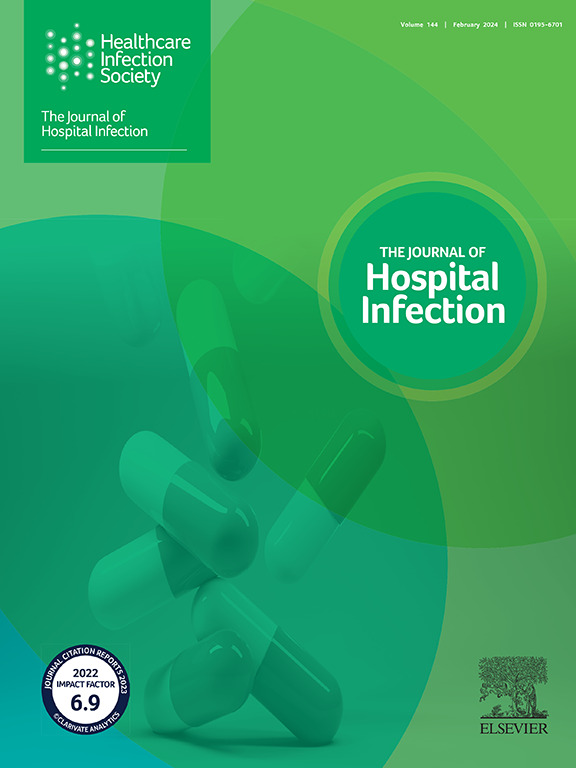Acanthamoebae as a protective reservoir for Pseudomonas aeruginosa in a clinical environment
IF 3.9
3区 医学
Q1 INFECTIOUS DISEASES
引用次数: 0
Abstract
Background
Pseudomonas aeruginosa is a growing concern in healthcare-associated infections and poses significant risk to those with serious underlying health conditions. The antimicrobial resistance traits of the pathogen and ability to form biofilms make effective mitigation and disinfection strategies difficult. Added to this challenge is the role that free-living amoebae such as Acanthamoeba play in the detection, disinfection and transmission of P. aeruginosa. P. aeruginosa can survive intracellularly within amoebae, which has the potential to limit detectability and permit transmission into high-risk areas.
Methods/findings
We screened for the presence of Acanthamoeba spp. and P. aeruginosa within a functioning general hospital in Scotland using a culture and molecular approach, noting their presence at several sites over a four-month period, particularly within floor drains connecting patient rooms. In addition, microbiome analysis revealed that amoebae harbour a unique microbial community comprised primarily of Pseudomonas spp. that were not readily detected using microbiome sequencing techniques on environmental swabs. Having demonstrated that both organisms were consistently present in hospital settings, we investigated the relationship between acanthamoeba and P. aeruginosa in the laboratory, showing that (i) acanthamoeba growth rate is increased in the presence of pseudomonas biofilms and viable pseudomonas persist within the amoebae and (ii) hydrogen peroxide-based disinfectants are significantly less effective against an isolate of P. aeruginosa in the presence of acanthamoeba than when the bacteria are incubated alone.
Conclusions
These findings suggest that amoebae, and other protists, can influence the detection and persistence of P. aeruginosa in high-risk areas and should be considered when implementing mitigation strategies.
在临床环境中,棘阿米巴是铜绿假单胞菌的保护库。
铜绿假单胞菌在与医疗相关的感染中日益受到关注,并对那些有严重潜在健康问题的人构成重大风险。病原体的抗菌特性和形成生物膜的能力使有效的缓解和消毒策略变得困难。此外,阿卡阿米巴等自由生活的阿米巴虫在铜绿假单胞菌的检测、消毒和传播中也扮演着重要角色。铜绿假单胞菌可在阿米巴原虫细胞内存活,这有可能限制其可检测性,并允许其传播到高风险地区。在此,我们采用培养和分子方法筛查了苏格兰一家正常运行的综合医院中是否存在阿卡阿米巴和铜绿假单胞菌,在 4 个月的时间里,我们在多个地点发现了它们的存在,尤其是在连接病房的地漏中。此外,微生物组分析表明,变形虫蕴藏着一个独特的微生物群落,主要由假单胞菌组成,使用微生物组测序技术在环境拭子上不易检测到假单胞菌。在证明这两种生物在医院环境中持续存在之后,我们在实验室中研究了棘阿米巴和铜绿假单胞菌之间的关系,结果表明:i)棘阿米巴的生长速度在假单胞菌生物膜存在的情况下会增加,并且有活力的假单胞菌会在阿米巴内持续存在;ii)过氧化氢类消毒剂在棘阿米巴存在的情况下对铜绿假单胞菌分离株的杀灭效果明显低于细菌单独培养的情况。这些发现表明,阿米巴原虫和其他原生动物会影响高风险地区铜绿假单胞菌的检测和持续存在,因此在实施缓解策略时应加以考虑。
本文章由计算机程序翻译,如有差异,请以英文原文为准。
求助全文
约1分钟内获得全文
求助全文
来源期刊

Journal of Hospital Infection
医学-传染病学
CiteScore
12.70
自引率
5.80%
发文量
271
审稿时长
19 days
期刊介绍:
The Journal of Hospital Infection is the editorially independent scientific publication of the Healthcare Infection Society. The aim of the Journal is to publish high quality research and information relating to infection prevention and control that is relevant to an international audience.
The Journal welcomes submissions that relate to all aspects of infection prevention and control in healthcare settings. This includes submissions that:
provide new insight into the epidemiology, surveillance, or prevention and control of healthcare-associated infections and antimicrobial resistance in healthcare settings;
provide new insight into cleaning, disinfection and decontamination;
provide new insight into the design of healthcare premises;
describe novel aspects of outbreaks of infection;
throw light on techniques for effective antimicrobial stewardship;
describe novel techniques (laboratory-based or point of care) for the detection of infection or antimicrobial resistance in the healthcare setting, particularly if these can be used to facilitate infection prevention and control;
improve understanding of the motivations of safe healthcare behaviour, or describe techniques for achieving behavioural and cultural change;
improve understanding of the use of IT systems in infection surveillance and prevention and control.
 求助内容:
求助内容: 应助结果提醒方式:
应助结果提醒方式:


